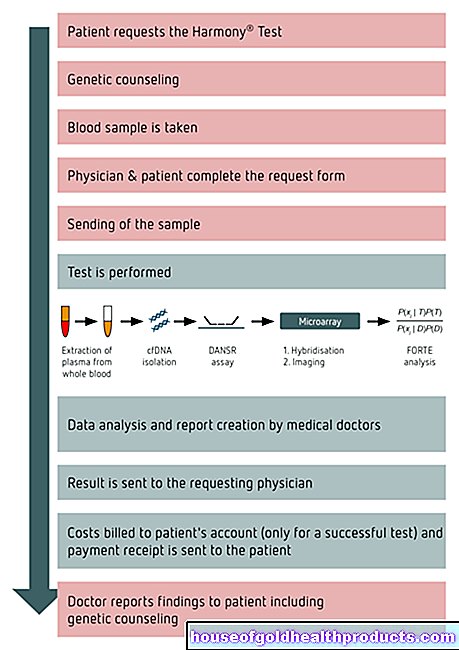Talk therapy
Updated onJulia Dobmeier is currently completing her master's degree in clinical psychology. Since the beginning of her studies, she has been particularly interested in the treatment and research of mental illnesses. In doing so, they are particularly motivated by the idea of enabling those affected to enjoy a higher quality of life by conveying knowledge in a way that is easy to understand.
More about the experts All content is checked by medical journalists.Talk therapy is one of the most common forms of psychotherapy. It aims to uncover problematic thought patterns, to get to know yourself better and thereby develop further. The attitude of the therapist plays a central role. The therapist creates a climate of appreciation and acceptance in which the patient can open up. Read here how talk therapy works and when it is suitable.

What is talk therapy?
Talk therapy - also called talk psychotherapy, client-centered, person-centered or non-directive psychotherapy - was founded in the middle of the 20th century by the psychologist Carl R. Rogers. It belongs to the so-called humanistic therapies. These assume that people want to constantly develop and grow. The therapist supports this so-called actualization tendency by helping the patient to realize himself.
In contrast to other forms of therapy, talk therapy does not focus on the patient's problems, but on his or her development potential in the here and now.
According to the concept of talk therapy, mental disorders arise when someone has problems accepting and valuing themselves. So the person concerned sees himself or herself distorted and not as he or she really is. For example, the person sees himself as brave, but shies away from challenges. This creates an incongruity - a mismatch. This means that the patient has an image of himself that is inconsistent with his experience. This disagreement creates fear and pain. Talk therapy starts with this thesis for the development of mental disorders.
Conditions for talk therapy
Carl R. Rogers established six crucial conditions for talk therapy:
- It is necessary for the interaction that there is contact between the therapist and the patient.
- The patient is in an incongruent state that scares them and makes them vulnerable.
- The therapist is in a congruent state. This means that he is truthful to the patient and does not pretend.
- The therapist unconditionally accepts the patient.
- The therapist empathizes with the patient without getting lost in his feelings.
- The patient perceives the therapist as empathetic and feels unconditionally accepted and valued.
When do you do talk therapy?
Talk therapy is successfully used in the treatment of mental disorders. Often it is an anxiety or obsessive-compulsive disorder, depression or addiction disorder.
As stated in the above conditions for talk therapy, this psychotherapeutic procedure is only suitable if a person perceives a discrepancy (incongruence) between their self-image and their experiences. In addition, you should have a certain willingness to explore yourself more closely.
Talk therapy is unsuitable for psychotic symptoms and some personality disorders because those affected have no understanding of the problem. Talk therapy is also not recommended if the person has difficulty expressing himself or herself using language or reflecting on himself.
In the first trial sessions, the patient can find out whether this type of therapy suits him. In addition, the therapist pays attention to the above-mentioned conditions and reports back to the patient as to whether the talk therapy is suitable for him or not.
What do you do in talk therapy?
In the first therapy sessions, the therapist makes the diagnosis and asks about the history. The patient then determines which goals he would like to achieve in therapy.
The core of talk therapy is the conversation between patient and therapist. The patient describes his problems and his points of view. The therapist tries to understand the patient's feelings and thoughts as precisely as possible.
Client-centered interviewing is based on the therapist repeatedly summarizing the patient's statements in his own words. Through the therapist's reflection, the patient comes to a better understanding of his inner world.
What the therapist does not do in talk therapy is to give advice or directions to the patient. So he does not tell the patient how to behave, but rather helps him to find an individual answer in himself.
Basic therapeutic attitude
Carl R. Rogers assumed that in psychotherapy it is less the technique than the therapeutic attitude towards the patient that plays the decisive role. Talk therapy therefore includes the therapist adopting a warm, empathetic and unconditionally appreciative attitude towards the patient. He does not judge the patient and shows him respect and respect. This should automatically make changes in the patient. If the patient feels safe and secure in therapy, he can explore without hesitation which internal conflicts are troubling him and express them freely.
Change self-image
Many patients suffer because they see the cause of their unhappiness in external conditions that they cannot change. In talk therapy, the therapist leads to the inner processes that cause suffering.
A common cause of suffering is, for example, distorted perceptions. The patient learns to check general judgments ("Nobody likes me") exactly. This gives him a more realistic point of view in the course of the talk therapy ("My family and friends like me, even if we sometimes have disagreements").
The aim of counseling psychotherapy is that the patient treats himself with respect and learns to see and accept himself for who he is. He can openly accept the experiences he has and does not have to suppress or distort. The patient is then congruent, which means that his self-image corresponds to his experiences.
What are the risks of talk therapy?
Like any psychotherapy, talk therapy can in some cases worsen or fail to improve symptoms.
The relationship between therapist and patient has a major influence on the success of the therapy. It is therefore important that the patient has confidence in the therapist. If this is not the case, a change of therapist makes sense.
In addition, talk therapy is not suitable for everyone. Talk therapy will not be successful, for example, if the patient has difficulty reflecting on himself or accepting the therapist's offer of a relationship. Even people who are generally capable of doing this can lose these abilities in severe psychological crises. People in need of stronger guidance may find it easier to use behavioral techniques.
What do I have to consider after talk therapy?
In the course of talk therapy, a strong bond often develops between patient and therapist. Many patients feel very comfortable in the warm and appreciative climate of talk therapy and are afraid when the therapy comes to an end.
Such fears and worries are perfectly normal. However, it is important that the patient communicates such negative thoughts and fears to the therapist - even if at the end of the therapy he feels that he is not feeling better. The therapist and patient can then clarify together whether an extension of the therapy is necessary or perhaps another therapist or another form of therapy would be the better solution.
In order to make it easier for the therapist to end the therapy, the therapist can gradually increase the intervals between the sessions - the therapy is "tapered off" so that the patient gets used to being able to cope with everyday life without the talk therapy.
Tags: parasites news pregnancy birth





























